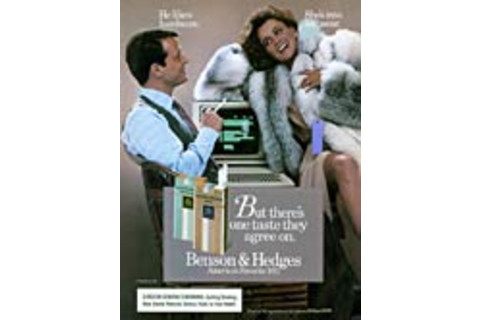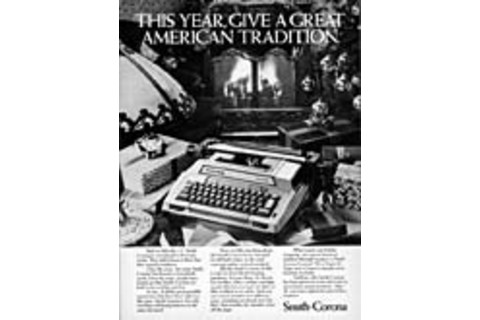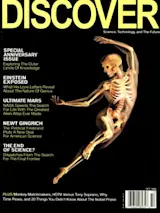For its 25th anniversary, Discoverexplored scientific progress as it had appeared on our editorial pages. This month, on the magazine's 26th anniversary, we examine another story of progress—one told through Discover's ads.
A clean-cut man sits beside a clunky old computer, a cigarette in his hand. Draped over the monitor is a woman swathed in a thick fur coat and a dress hitched several inches above her knees, smiling adoringly at the smoker as he nuzzles her foot with his shoe. "He likes hardware," says the advertisement for Benson & Hedges cigarettes. "She's into softwear."

Dripping with Freudian innuendo, the advertisement seems mired in a bygone age—the 1950s, perhaps—when men took charge of machines, women wore (and were) fluff, and smoking was sophisticated. Yet this cigarette ad appears in—egad—a modern science magazine: the December 1985 issue of Discover. Only the computer hints at the ad's real vintage. No Internet icons, windows, or colorful graphics crowd the black screen, just mysterious long strings of green zeros.
To glance back over 26 years' worth of Discover ads is to glimpse a lost world of electric typewriters, Polaroid cameras, Atari video games, and smokers, smokers galore. It is a slide show of the past that tells us as much as—if not more than—the articles themselves about the rapid evolution of technology, social mores, and attitudes toward health. From the arrival of e-mail to the advent of Viagra and the Prius hybrid car, the ads unfold a fascinating tour of two and a half decades of science, medicine, and environmental change.
Flick open the premier (October 1980) issue of Discover—now so rare it's kept in a locked drawer in our editorial offices—and one is offered "the first personal computer for under $200," the Sinclair ZX80, which billed itself as "a complete, powerful, full-function computer," with one kilobyte of user memory. Today that memory would be maxed out by a single e-mail message. (By contrast, a 2006 PC may have one gigabyte of memory on its hard drive—one million times that of a ZX80.) "You simply take it out of the box, connect it to your TV, and turn it on," gabs the ad. "Within a week, you'll be writing complex programs with confidence." Never mind blogging or music downloads: In 1980, when home computers were so rare that no reliable ownership statistics exist, ZX80 users wrote their own programs in BASIC code—mostly for simple games like Lunar Lander and Blackjack, and stored them on cassette tapes.

But we can't all be early adopters. Despite the popularity of the ZX80—the company purportedly sold 100,000 of them worldwide that year—the readers of Discover were evidently still clacking away on typewriters in 1981. That's when Smith-Corona wedged its electric Coronet XL under a Christmas tree in the December issue, touting its "brand-new Lift-Rite" correction system "that actually lifts mistakes clean off the page!" If the ads were reaching a receptive audience, then subscribers were also playing Space Invadersand Missile Command on their Atari systems, proudly recording up to six full hours on a single cassette with their RCA Convertible SelectaVision VCRs and snapping away with the four-inch-wide Polaroid OneStep, "the world's simplest camera," to which the manufacturer had recently added the "amazing, detachable Q-light strobe."
Like home computers, cell phones in the early 1980s were an alien notion to most Americans. (The first commercially available mobile phone in the United States, the brick-size Motorola DynaTAC 8000X, was launched in 1983.) In October 1980, the farthest aDiscover reader could hope to rove from the house with a telephone was 300 feet, with the aid of the Phone Ranger, a boxy portable push-button telephone with a rechargeable battery whose base unit plugged into a house jack. The satisfied user pictured in the ad perches the phone precariously on a rock, stretches the curly wire taut, and boasts into the receiver that he can "groom Laird, my Palomino gelding, with one hand and call my broker with the other."
From that point on, everything grew smaller, sleeker, and faster: Tiny digital cameras replaced ancestral Polaroids, Zip disks cast out floppies, DVDs thrust aside videotape, and ever-slimmer cell phones and Palm Pilots proliferated. In the year 2000, Sony publicized its 64-megabyte Memory Stick, which could store digital images, video and digital music files, and—if its oddly elegant ad campaign could be believed—slotted directly into the back of a man's head.
What of the Internet? The military was busy building computer networks as far back as the 1960s, and by 1983 a university network was up and running. But the first indication that Discover readers might be so bold as to contact each other electronically came in 1984, when CompuServe advertised its "Personal Communications Network for Every Computer Owner." Using its Electronic Mail system ("we call it Email™"), CompuServe subscribers could deliver "any number of messages to other users anywhere in North America." In the ad, a pajama-clad couple in a tchotchke-choked living room smile as they celebrate the online party they just held for 11 people in nine different states "and only had to wash one glass."
By 1985 CompuServe users could do much more. They could log on to the Electronic Mall (though at the time it wasn't clear what they could buy), scan flight availabilities ("on virtually any airline—worldwide"), look for medical advice on HealthNet, or seek sex counseling by sending an inquiry to the daily "Advice to the Lovelorn" column ("Hundreds turn to it for real answers"). Computers, too, were becoming more sophisticated: The Macintosh computer advertised in December 1987 had hard disks that stored "over 10,000 pages" and could incorporate an "Applefax modem" that "lets you send hard copy to any facsimile machine in the world."
In 1994 the World Wide Web was entering common usage. IBM was peddling its now virtually defunct operating system, OS/2, "the new 32-bit, multitasking, multimedia, Internet-accessed, crash-protected, Windows-friendly, easy-to-install totally cool way to run your computer," which allowed users to "warp" onto the Internet (a piece of corporate-created slang snitched from Star Trek that never caught on). Another innovation that apparently fizzled and died was WebTV ("The Internet. The ultimate resource. Now showing on a TV near you"), advertised in Discover in 1996. By thenDiscover itself was online: In 1995 it announced with fanfare that readers could now communicate directly with our staff "and read special Digital Content" by checking us out on the "Internet World Wide Web" at an obsolete site since superseded by www.Discover.com.
What else did the Web offer? In 1998 online shopping was fully available (the extinct egghead.com, a site now subsumed into Amazon, offered 30,000 products from its superstores as well as "action-packed online bidding" at its auctions); e-fiction had appeared, courtesy of IBM and Borders.com, and search engines like AltaVista dominated a pre-Google world. But perhaps the most dated of the technology ads was one that appeared in November 1999: It depicts a man sitting at a computer in a narrow Spanish street, oblivious as the rampaging bulls of Pamplona charge down upon him. "Y2K's coming. Don't just sit there," says the text, which promotes Iomega's Y2K Software Suite. "Back up your files, update, and protect your PC well into the next millennium." In our post 9/11 world, the ominous warning of the coming (and ultimately imaginary) computer apocalypse seems almost quaint.
It's not only gadgets that show the passage of time. To the health-obsessed eye of 2006—a time in which smokers are outcasts and the addiction akin to a moral vice—the profusion of cigarette ads in Discover during its first decade can be jarring. Nevertheless, in the mid-1980s, when nearly a third of the American public smoked (as compared with 20 percent now), the magazine's pages were splattered with them. The harmful effects of the habit were hardly unknown—the first major study definitively linking smoking to lung cancer had been published in 1950 in the Journal of the American Medical Association. Despite this—or perhaps to refute the risks—the smokers in the ads seem vigorous and healthy, rappelling rock faces, lassoing horses, batting snowballs with baseball bats, or as in a peculiar December 1982 ad for Newport Menthol Kings ("Alive with pleasure!"), sticking a Santa Claus beard on a woman's face.
Only after 1991—the year the family-friendly Walt Disney Company acquired Discover—do the cigarettes ads disappear, reflecting not only corporate policy but a sea change in the culture. In 1994 tobacco industry executives were hauled before Congress to defend themselves, en masse, for the first time—and were soon to face multibillion-dollar lawsuits by states seeking to recoup the cost of caring for people with smoking-related diseases. By 1997 the only reference to tobacco was an ad for Nicorette Gum Stop Smoking Aid. Health awareness, body image, and virility were creeping into public consciousness in the 1990s, with musclemen touting the benefits of bodybuilding machines like the NordicTrack.
In 1993 the baldness-battling remedy Rogaine pops up in the pages of Discover and in November 1999—what else?—Viagra. By 2005, however, diabetes drugs were being promoted—reflecting a near tripling of the incidence of diabetes in the United States in the past quarter century, from 5.8 million people with the disease in 1980 to 14.7 million in 2004. Obesity, too, was on the rise: In 1980 less than 50 percent of Americans were overweight or obese; in 2004, two-thirds of the population was fat.
Car sizes expanded along with the waistlines. In 1980 ads for the compact Ford Escort boasted a higher gas mileage rating than smaller cars like the Volkswagen Rabbit; 20 years later, gas-guzzling SUVs were racing through the pages of Discover instead. Nonetheless, a growing awareness of environmental issues began seeping into Discover's ad pages, reflecting new pressures on the oil and automobile industries and a new sensibility among consumers. In 1994 the Chrysler Corporation had a gaggle of hapless cartoon penguins peer through a hole in the ozone layer in its ad for new vehicles fitted with air conditioners free of destructive chlorofluorocarbons. Toyota promoted the "world's first mass-produced gas/electric vehicle," the Prius, in December 2000.
By 2004, BP was styling itself "Beyond Petroleum," and GM was predicting a new generation of cars and trucks powered by hydrogen, "where the only emission is water vapor." Just one year earlier, the Shell Oil Company had printed the dread words global warming in an ad that invited readers to e-mail their opinions to its Texas headquarters.
"We believe that action needs to be taken now, both by companies and their customers," their advertisement said. When an oil company trumpets the need to tackle climate change, you know that the world has been transformed.














